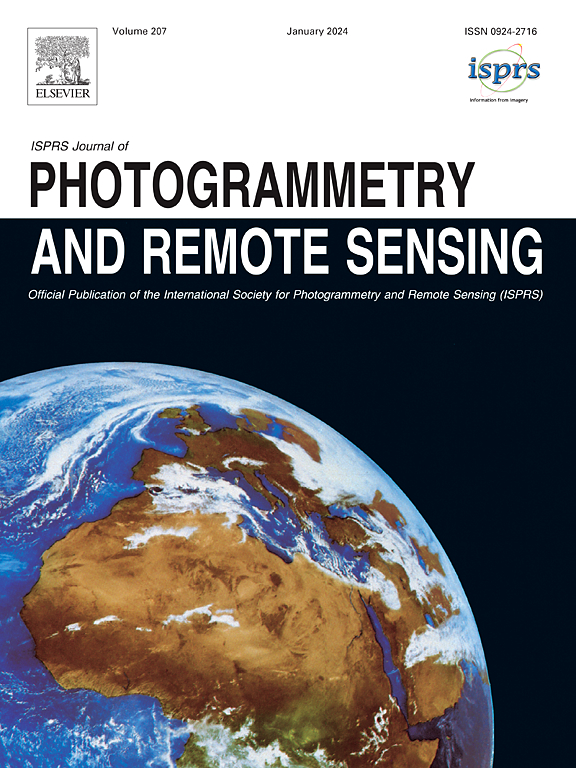On-orbit geometric calibration of MERSI whiskbroom scanner
IF 10.6
1区 地球科学
Q1 GEOGRAPHY, PHYSICAL
ISPRS Journal of Photogrammetry and Remote Sensing
Pub Date : 2024-11-18
DOI:10.1016/j.isprsjprs.2024.11.007
引用次数: 0
Abstract
The whiskbroom scanner is a critical component in remote sensing payloads, such as the Visible Infrared Imaging Radiometer Suite (VIIRS) on the Joint Polar Satellite System (JPSS) and the Medium Resolution Spectral Imager (MERSI) on FengYun-3. However, panoramic distortion in whiskbroom scanner images increases overlap from the nadir to the edges between adjacent scans. These distortions present significant challenges for improving geolocation accuracy, particularly when errors occur in sensors and platforms. This manuscript derives analytic expressions for all potential error sources, including sensors, platforms, and elevation, using homogeneous coordinates in the focal plane. This derivation demonstrates that geolocation errors vary with view angles and detector positions. To further investigate these error properties, a gradient-aware least-squares matching method was developed to extract highly accurate and dense ground control points (GCPs) with approximately 100,000 points in a single scene. A three-step geometric calibration method was then introduced, which includes boresight misalignment correction, parametric geometric calibration, and non-uniform scanning compensation. Given the varying spatial resolution of the GCPs, the weight of the GCPs was dynamically updated for least-squares estimation. This method effectively demonstrated the complex geolocation errors in MERSI on FY-3D, a system that was not meticulously calibrated in the laboratory. The initial root mean square errors (RMSEs) were 3.354 and 12.441 instantaneous field of view (IFoV) for the designed parameters. The proposed geometric calibration method successfully corrected view-angle and detector position-related geolocation errors, reducing them to 0.211 and 0.225 IFoV in the scan and track directions, respectively. The geolocation validation software and experiment results were provided https://github.com/hongbop/whiskgeovalidation.git.
MERSI 啸扫扫描仪的在轨几何校准
拂尘扫描仪是遥感有效载荷的一个重要组成部分,如联合极地卫星系统(JPSS)上的可见光红外成像辐射计套件(VIIRS)和风云三号上的中分辨率光谱成像仪(MERSI)。然而,拂尘扫描仪图像的全景失真会增加相邻扫描之间从天底到边缘的重叠。这些失真给提高地理定位精度带来了巨大挑战,特别是当传感器和平台出现误差时。本手稿利用焦平面上的均质坐标,推导出所有潜在误差源的分析表达式,包括传感器、平台和仰角。推导结果表明,地理定位误差随视角和探测器位置的变化而变化。为了进一步研究这些误差特性,我们开发了一种梯度感知最小二乘匹配方法,以提取高精度、高密度的地面控制点(GCP),单个场景中大约有 100,000 个点。然后引入了三步几何校准法,包括孔径偏差校正、参数几何校准和非均匀扫描补偿。鉴于 GCP 的空间分辨率不同,GCP 的权重被动态更新,以进行最小二乘估计。这种方法有效地展示了 FY-3D 上 MERSI 系统的复杂地理定位误差,而该系统并未在实验室中进行细致校准。设计参数的初始均方根误差(RMSE)分别为 3.354 和 12.441 瞬时视场(IFoV)。所提出的几何校准方法成功校正了与视角和探测器位置相关的地理定位误差,在扫描和跟踪方向将误差分别减小到 0.211 和 0.225 IFoV。地理定位验证软件和实验结果见 https://github.com/hongbop/whiskgeovalidation.git。
本文章由计算机程序翻译,如有差异,请以英文原文为准。
求助全文
约1分钟内获得全文
求助全文
来源期刊

ISPRS Journal of Photogrammetry and Remote Sensing
工程技术-成像科学与照相技术
CiteScore
21.00
自引率
6.30%
发文量
273
审稿时长
40 days
期刊介绍:
The ISPRS Journal of Photogrammetry and Remote Sensing (P&RS) serves as the official journal of the International Society for Photogrammetry and Remote Sensing (ISPRS). It acts as a platform for scientists and professionals worldwide who are involved in various disciplines that utilize photogrammetry, remote sensing, spatial information systems, computer vision, and related fields. The journal aims to facilitate communication and dissemination of advancements in these disciplines, while also acting as a comprehensive source of reference and archive.
P&RS endeavors to publish high-quality, peer-reviewed research papers that are preferably original and have not been published before. These papers can cover scientific/research, technological development, or application/practical aspects. Additionally, the journal welcomes papers that are based on presentations from ISPRS meetings, as long as they are considered significant contributions to the aforementioned fields.
In particular, P&RS encourages the submission of papers that are of broad scientific interest, showcase innovative applications (especially in emerging fields), have an interdisciplinary focus, discuss topics that have received limited attention in P&RS or related journals, or explore new directions in scientific or professional realms. It is preferred that theoretical papers include practical applications, while papers focusing on systems and applications should include a theoretical background.
 求助内容:
求助内容: 应助结果提醒方式:
应助结果提醒方式:


